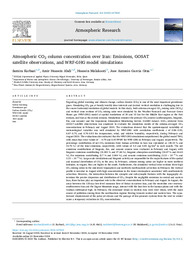Resumen :
Regarding global warming and climate change, carbon dioxide (CO2) is one of the most important greenhouse gases. Simulating CO2 gas at hourly/weekly time intervals and desired vertical resolution is challenging due to the coarse horizontal resolution of global models. In this study, both column-averaged CO2 mixing ratio (XCO2) and vertical cross sections of CO2 mixing ratio were simulated by the Weather Research and Forecast Green House gas (WRF-GHG) model at spatial resolutions of 30 and 10 km for the Middle East region as the first domain, and Iran as the second domain. Simulations consider the primary CO2 sources (anthropogenic, biogenic, fire, and oceanic) and the Copernicus Atmosphere Monitoring Service (CAMS) dataset. XCO2 retrieved from GOSAT satellite observations was employed to evaluate the simulation results of the column-averaged CO2 concentrations in February and August 2010. The evaluations showed that the spatiotemporal variability of meteorological variables was well simulated by WRF-GHG with correlation coefficients r of 0.86–0.92, 0.67–0.75, and 0.76–0.82 for temperature, wind, and relative humidity, respectively, during February and August 2010. The evaluations also indicated that the WRF-GHG simulations outperformed the global model TM3, with mean bias error values of − 0.79 and 0.45 PPMV for WRF-GHG in February and August, respectively. The percentage contribution of net CO2 emissions from human activities in Iran was calculated as (38.33 % and 23.70 %) of the total emissions, respectively, with values of 4.4 and 0.85 kg/km2 in each month. The net emissions contributions of biogenic, fire, and oceanic sources were evaluated in February and August, with biogenic emissions contributing (31.901 % and 27.66 %), biogenic absorption contributing (24.07 % and 46.63 %), fire emissions contributing (5.7 % and 2.064 %), and oceanic emissions contributing (3.23 × 10−6 % and 2.23 × 10−6 %). Large-scale circulations and biogenic activity are responsible for the major features of the spatial and seasonal distribution of CO2 in the area. In February, column mixing ratios are higher in more northern latitudes; in August, they are higher to the south. Furthermore, the simulated vertical cross sections show high CO2 mixing ratios in the mid-lower troposphere and northerly/northeasterly advection in February; the vertical profile is inverted in August with high concentrations in the lower stratosphere associated with southwesterly advection. However, the interaction between the synoptic and sub-synoptic features with the topography determines the precise dispersion and distribution of CO2. Despite the negligible emissions in central and eastern Iran, these factors play an important role in the observed concentrations in February and August. In August, the areas between the 120-day low-level monsoon flow of Sistan in eastern Iran, and the westerlies over western/southwestern Iran and the Zagros Mountain range, interact with the heat-low in the Iranian plains and with the Arabian subtropical high. In February, the dominant winds in western Asia were west winds, with the main source of pollution coming from the northeastern regions flowing towards central and eastern Iran. The equatorward displacement of the polar jet stream and the passage of low-pressure systems from the west in winter cause a temporary reduction in CO2 concentrations.
|

 La licencia se describe como: Atribución-NonComercial-NoDerivada 4.0 Internacional.
La licencia se describe como: Atribución-NonComercial-NoDerivada 4.0 Internacional.
.png)